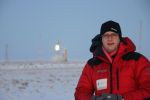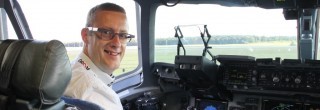Baikonur Cosmodrome is the largest space port in the world. Thousands of launches have taken place from here, making it the true birth place of space exploration. Worldwide it is only rivaled by Kennedy Space Center in the United States. Many ‘firsts’ in space were constructed and launched from Baikonur, starting with Sputnik, the world’s first satellite, in 1957. The first person in space, Yuri Gagarin, launched from here in 1961, as did the first woman in space, Valentina Tereshkova, in 1963. Continue reading
Asia
My travel reports from Asia, including the Middle East
Baikonur Cosmodrome – The Last Place on Earth
 Baikonur Cosmodrome. Located literally in the middle of nowhere in Central Asia. Hardly an attractive or easy place to travel to. Yet on the bucketlist of most of my spacegeek-friends on social media. I have written a few posts on this place already, most recently writing a travel guide to the city of Baikonur. This post describes Baikonur Cosmodrome from the perspective of its most important visitors. For space travelers Baikonur truly is the Last Place on Earth. Next stop: Space! Continue reading
Baikonur Cosmodrome. Located literally in the middle of nowhere in Central Asia. Hardly an attractive or easy place to travel to. Yet on the bucketlist of most of my spacegeek-friends on social media. I have written a few posts on this place already, most recently writing a travel guide to the city of Baikonur. This post describes Baikonur Cosmodrome from the perspective of its most important visitors. For space travelers Baikonur truly is the Last Place on Earth. Next stop: Space! Continue reading
A space tourist on Earth
 Earlier today I published the space bucket list, containing all flown manned spaceflight vehicles on public display around the world. Reason for compiling this list was ongoing debate about specific spacecraft locations and people (including me) questioning the authenticity of certain spacecraft on display in museums. I visited a record number of spacecraft in museums in 2014. This blog post is an attempt to describe a specific (geeky?) travel theme and the diversity of destinations this covers, rather than a story about a destination. Join me on a virtual tour of Europe, Russia, Kazakhstan and the United States, all visited in 2014. Continue reading
Earlier today I published the space bucket list, containing all flown manned spaceflight vehicles on public display around the world. Reason for compiling this list was ongoing debate about specific spacecraft locations and people (including me) questioning the authenticity of certain spacecraft on display in museums. I visited a record number of spacecraft in museums in 2014. This blog post is an attempt to describe a specific (geeky?) travel theme and the diversity of destinations this covers, rather than a story about a destination. Join me on a virtual tour of Europe, Russia, Kazakhstan and the United States, all visited in 2014. Continue reading
Space City Baikonur – a travel guide
 There are a handful of places in the world that are on top of every space enthusiast’s bucket list. For the true space historian Baikonur has the top spot. This is the town where human’s voyage into space truly began, with the launch of the world’s first satellite, Sputnik 1 in 1957, quickly followed by the launch of the first man in space, Yuri Gagarin in 1961. If these two historic facts are not enough to make you want to visit, then the fact that this is the only place in the world (apart from China) where humans are being launched into space today, should convince you. Baikonur embodies the great past of spaceflight, but still counts as the most important space port in the world today, 59 years after construction began. Continue reading
There are a handful of places in the world that are on top of every space enthusiast’s bucket list. For the true space historian Baikonur has the top spot. This is the town where human’s voyage into space truly began, with the launch of the world’s first satellite, Sputnik 1 in 1957, quickly followed by the launch of the first man in space, Yuri Gagarin in 1961. If these two historic facts are not enough to make you want to visit, then the fact that this is the only place in the world (apart from China) where humans are being launched into space today, should convince you. Baikonur embodies the great past of spaceflight, but still counts as the most important space port in the world today, 59 years after construction began. Continue reading
Flying the Lucky Tupolev
 Russia is a great destination for aviation history fans. Where airlines all over the world nowadays operate the same ‘boring’ Boeing and Airbus jets, many Russian airlines still operate some more ‘exotic’ planes. Similarly, many Russian airports boast interesting aircraft ‘graveyards’, showing planes that totally belong in aircraft musea. Taking a flight in Russia can lead to interesting surprises, like my story here: Continue reading
Russia is a great destination for aviation history fans. Where airlines all over the world nowadays operate the same ‘boring’ Boeing and Airbus jets, many Russian airlines still operate some more ‘exotic’ planes. Similarly, many Russian airports boast interesting aircraft ‘graveyards’, showing planes that totally belong in aircraft musea. Taking a flight in Russia can lead to interesting surprises, like my story here: Continue reading
Citytrip to Almaty, Kazakhstan
 Here is one totally off the beaten track. Literally, because the tracks that lead to the largest city of Kazakhstan are long and virtually unknown to tourists. Cramped in the south-east corner of this immense country, at the spot where the flatlands meet the outskirts of the Tian Shan Mountains, this is not your average weekend city destination by any standards. Nevertheless, it is a city well-known to many Dutch sports enthusiasts. Usually the bell starts to ring when using the old Soviet name of the city: Alma-Ata. Alma-Ata was one of the first destinations in the world offering a high altitude speed skating rink, where European top skaters broke their early world records. Today’s tourism still mostly focuses on winter sports. The ski resorts are within easy reach of city center. Almaty lost its status as the capital of Kazakhstan to the smaller, but more central and hyper modern city of Astana in 1997. Continue reading
Here is one totally off the beaten track. Literally, because the tracks that lead to the largest city of Kazakhstan are long and virtually unknown to tourists. Cramped in the south-east corner of this immense country, at the spot where the flatlands meet the outskirts of the Tian Shan Mountains, this is not your average weekend city destination by any standards. Nevertheless, it is a city well-known to many Dutch sports enthusiasts. Usually the bell starts to ring when using the old Soviet name of the city: Alma-Ata. Alma-Ata was one of the first destinations in the world offering a high altitude speed skating rink, where European top skaters broke their early world records. Today’s tourism still mostly focuses on winter sports. The ski resorts are within easy reach of city center. Almaty lost its status as the capital of Kazakhstan to the smaller, but more central and hyper modern city of Astana in 1997. Continue reading
Beijing for Business
 Most of the time a businesstrip doesn’t leave a lot of time for sightseeing. I spent a week at a conference in Beijing, China in September 2013. Despite a very full schedule I managed to squeeze in some time for wandering around the Northern part of town. With the conference at the 2008 Olympic Park site, most of the wandering took place there. So what does an Olympic Park look like five years after the Olympics? Continue reading
Most of the time a businesstrip doesn’t leave a lot of time for sightseeing. I spent a week at a conference in Beijing, China in September 2013. Despite a very full schedule I managed to squeeze in some time for wandering around the Northern part of town. With the conference at the 2008 Olympic Park site, most of the wandering took place there. So what does an Olympic Park look like five years after the Olympics? Continue reading
The Russians always launch
Extreme weather no objection for Soyuz
 Circumstances at Baikonur were perfect when cosmonaut André Kuipers was launched into space last December: Temperatures around -30 degrees Centigrade and crystal clear skies. Why do the Russians continue using their remote base in the middle of Kazachstan’s endless steppe? Continue reading
Circumstances at Baikonur were perfect when cosmonaut André Kuipers was launched into space last December: Temperatures around -30 degrees Centigrade and crystal clear skies. Why do the Russians continue using their remote base in the middle of Kazachstan’s endless steppe? Continue reading
Baikonur blog – launch day!
More launch pads, SoyuzTweetup and a Launch!
 Baikonur, 21 December 2011 – Finally. Today is the day we have been living up to for a long time. The launch of Soyuz TMA-03M, with ‘the’ Dutch astronaut André Kuipers on board. It is still dark outside when I wake up around 8 o’clock. Today our program consists of two major visits. First we will go to the furthest launch location at the cosmodrome: the Proton launch facility. Then we have some time in the city before going to launch pad 1 for the launch in the early evening.
Baikonur, 21 December 2011 – Finally. Today is the day we have been living up to for a long time. The launch of Soyuz TMA-03M, with ‘the’ Dutch astronaut André Kuipers on board. It is still dark outside when I wake up around 8 o’clock. Today our program consists of two major visits. First we will go to the furthest launch location at the cosmodrome: the Proton launch facility. Then we have some time in the city before going to launch pad 1 for the launch in the early evening.
Baikonur blog – space history and more space history
Launch Pads, Shuttles and Public Outreach
 Baikonur, 20 December 2011 – After breakfast at our hotel we are greeted again by our guide Elena and driver Said. The uncomfortable van is heated up and waiting for us, this time with the Tsenki security lady already inside. When we leave she hands us two “cosmodrome rules” forms and asks us to sign a list with our names on it. No idea why this was not needed yesterday, but we happily comply. We are waved past the city exit checkpoint, and easily pass the cosmodrome entrance checkpoint. Then again a long empty road to the cosmodrome facilities. This time we go straight on, towards the far end of this middle section at site 250. This launch pad is no longer active, but of great historical importance, as it was built for the Russian space shuttle Buran in the 1980’s.
Baikonur, 20 December 2011 – After breakfast at our hotel we are greeted again by our guide Elena and driver Said. The uncomfortable van is heated up and waiting for us, this time with the Tsenki security lady already inside. When we leave she hands us two “cosmodrome rules” forms and asks us to sign a list with our names on it. No idea why this was not needed yesterday, but we happily comply. We are waved past the city exit checkpoint, and easily pass the cosmodrome entrance checkpoint. Then again a long empty road to the cosmodrome facilities. This time we go straight on, towards the far end of this middle section at site 250. This launch pad is no longer active, but of great historical importance, as it was built for the Russian space shuttle Buran in the 1980’s.
Continue reading

